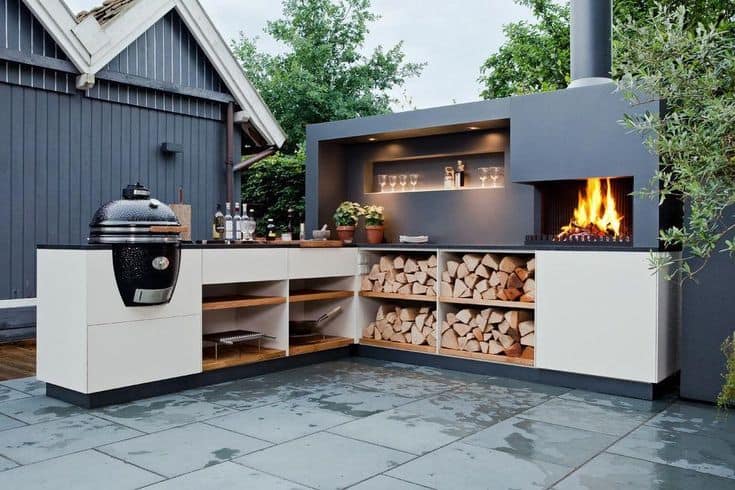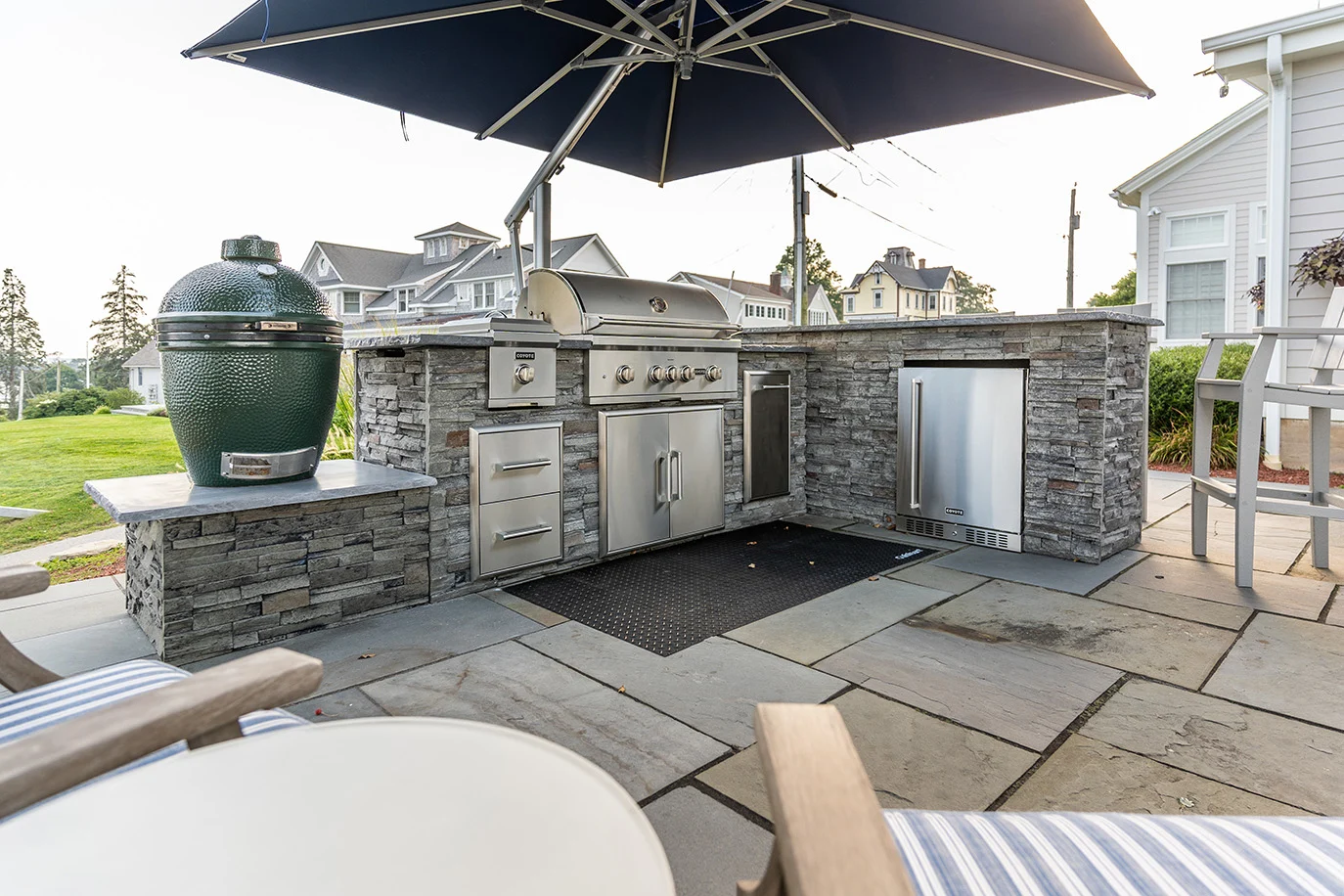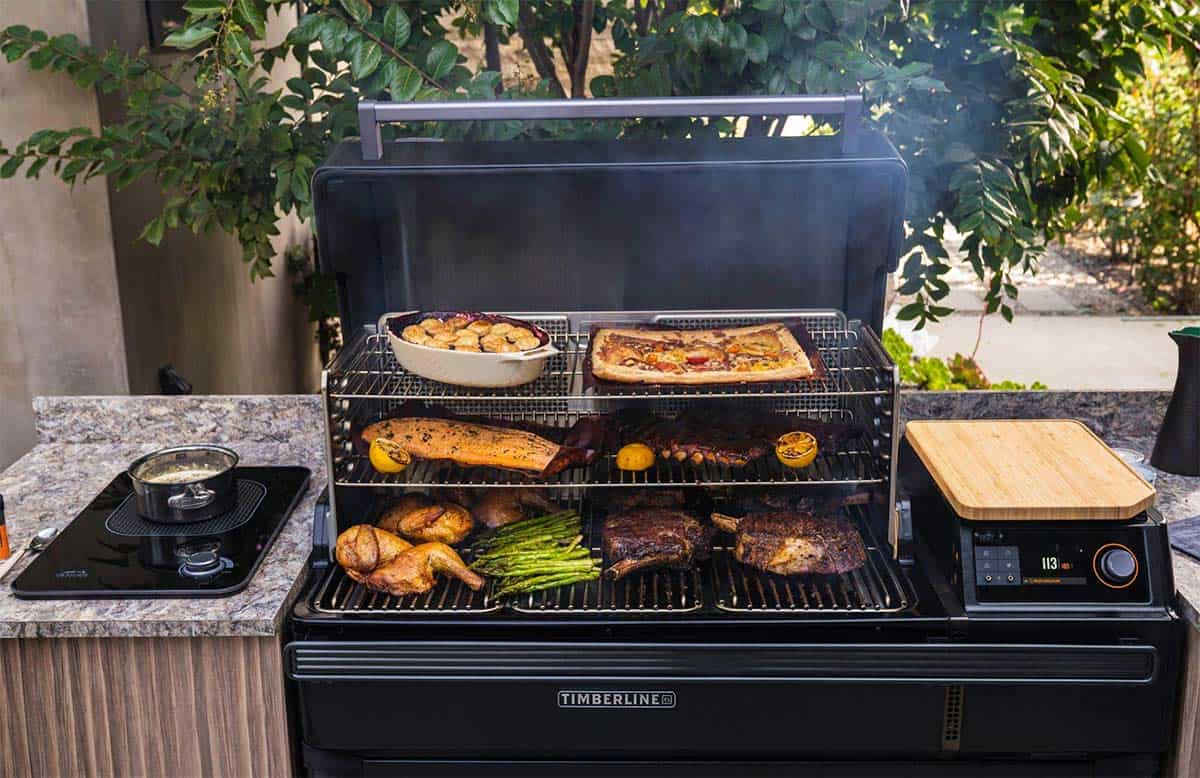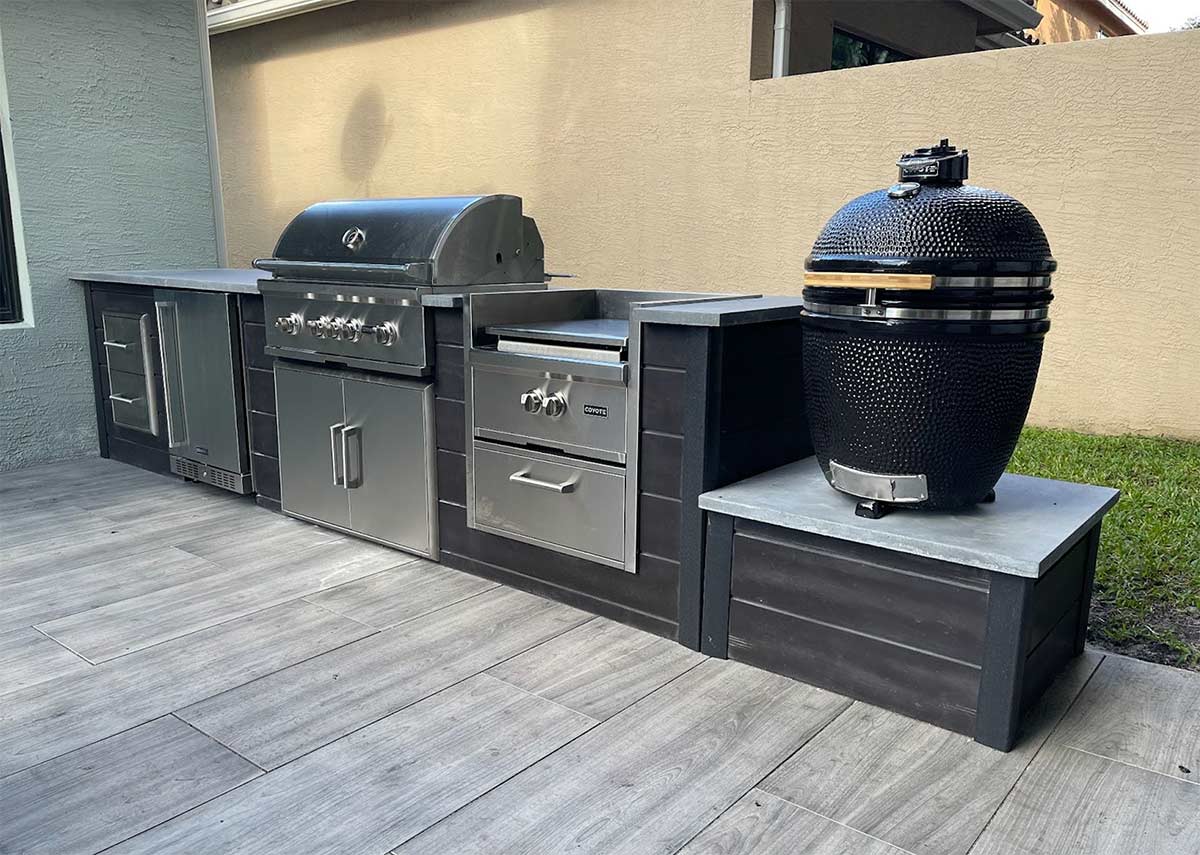An outdoor kitchen built-in smoker is a permanent fixture designed to seamlessly integrate with outdoor cooking spaces, providing a dedicated area for smoking meats and other foods.
Outdoor cooking has become increasingly popular in recent years, with more and more people embracing the idea of creating a fully functional outdoor kitchen. These outdoor kitchens are equipped with all the necessary appliances and tools to cook delicious meals while enjoying the great outdoors. One must-have addition to any outdoor kitchen is a built-in smoker. A built-in smoker not only adds a unique flavor and texture to your meat but also offers versatility and convenience.
The Benefits of a Built-In Smoker for Outdoor Cooking
One of the main benefits of having a built-in smoker in your outdoor kitchen is the unique flavor and texture that smoking adds to meat. Smoking infuses the meat with a smoky aroma and flavor that cannot be replicated by any other cooking method. The slow cooking process also results in tender, juicy meat that melts in your mouth.
Another advantage of a built-in smoker is its versatility. With a smoker, you can cook a variety of meats and dishes, from ribs and brisket to chicken and vegetables. The low and slow cooking method allows you to experiment with different flavors and techniques, creating endless possibilities for delicious meals.
Having a built-in smoker in your outdoor kitchen also offers convenience. Instead of having to set up a separate smoker every time you want to smoke meat, a built-in smoker is always ready to use. It saves you time and effort, allowing you to focus on enjoying the cooking process and spending time with your family and friends.
How to Choose the Right Built-In Smoker for Your Outdoor Kitchen
When choosing a built-in smoker for your outdoor kitchen, there are several factors to consider. First, you need to decide on the type of smoker you want. There are three main types: electric, gas, and charcoal smokers. Each type has its own advantages and disadvantages, so it’s important to research and understand the differences before making a decision.
Size is another important consideration. You need to make sure that the smoker you choose fits well in your outdoor kitchen and can accommodate the amount of food you plan to smoke. Budget is also a factor to consider, as smokers can vary greatly in price. Set a budget and look for a smoker that offers the best value for your money.
Lastly, consider the features that are important to you. Some smokers come with built-in thermometers, temperature control systems, and even Wi-Fi connectivity. Think about what features are essential for your cooking style and choose a smoker that meets your needs.
Designing Your Outdoor Kitchen with a Built-In Smoker in Mind
When designing your outdoor kitchen, it’s important to plan the layout with a built-in smoker in mind. Consider the size and placement of the smoker to ensure that it fits seamlessly into your design. You may want to position the smoker near a countertop or prep area for easy access while cooking.
Integrating your smoker into your outdoor kitchen design has several benefits. It creates a cohesive and visually appealing space, making your outdoor kitchen look more professional and well-designed. It also allows for better functionality, as you can easily move between different cooking areas without having to leave the smoker unattended.
To design an outdoor kitchen with a built-in smoker in mind, consider the flow of your cooking process. Think about how you will move from prepping to cooking to serving, and make sure that everything is within reach. Also, consider ventilation and safety measures to ensure that smoke is properly directed away from your cooking area.
The Different Types of Wood Chips and Their Flavors for Smoking
Choosing the right wood chips is crucial for achieving the desired flavor when smoking meat. Different types of wood chips impart different flavors, so it’s important to understand their characteristics and choose accordingly.
Some popular types of wood chips include hickory, mesquite, apple, cherry, and oak. Hickory is known for its strong, smoky flavor and is often used for smoking beef and pork. Mesquite has a bold, earthy flavor that pairs well with red meats. Apple and cherry wood chips offer a sweeter, fruitier flavor that complements poultry and pork. Oak is a versatile wood chip that provides a mild, smoky flavor and can be used with a variety of meats.
| Wood Type | Flavor Profile | Best Matches |
|---|---|---|
| Apple | Mild, fruity | Chicken, Turkey, Pork, Fish, Vegetables |
| Cherry | Sweet, mild | Chicken, Turkey, Pork, Beef, Lamb, Duck |
| Hickory | Strong, bacon-like | Pork (especially ribs), Beef, Game Meats |
| Mesquite | Strong, earthy | Beef, Lamb, Game Meats, Poultry (sparingly) |
| Pecan | Sweet, nutty | Chicken, Turkey, Pork, Beef, Lamb |
| Oak | Medium, versatile | Beef, Lamb, Game Meats, Pork, Poultry |
| Alder | Mild, slightly sweet | Fish, Seafood, Poultry, Pork |
| Maple | Mild, slightly sweet | Pork, Poultry, Vegetables |
| Peach | Mild, fruity | Pork, Chicken, Turkey, Fish |
| Cedar | Strong, aromatic | Salmon, Seafood, Poultry |
| Walnut | Rich, robust | Red meats, Pork, Game Meats |
| Pecan | Sweet, nutty | Chicken, Turkey, Pork, Beef, Lamb |
| Grapevines | Sweet, fruity | Poultry, Pork, Vegetables |
| Olive | Mild, fruity | Lamb, Poultry, Pork |
When selecting wood chips, consider the intensity of the flavor you want to achieve and the type of meat you are smoking. Experiment with different combinations to find your preferred flavor profile.
Prepping Your Meat for Smoking: Tips and Techniques
Properly preparing your meat before smoking is essential for achieving the best results. There are several techniques you can use to enhance the flavor and tenderness of your meat.
One technique is brining, which involves soaking the meat in a saltwater solution before smoking. Brining helps to tenderize the meat and infuse it with flavor. You can add herbs, spices, and other seasonings to the brine to enhance the taste even further.
Marinating is another popular technique for prepping meat for smoking. Marinating involves soaking the meat in a mixture of oil, acid (such as vinegar or citrus juice), and seasonings. This helps to tenderize the meat and infuse it with flavor. The longer you marinate the meat, the more pronounced the flavors will be.
Dry rubs are also commonly used to prep meat for smoking. A dry rub is a mixture of herbs, spices, salt, and sugar that is rubbed onto the surface of the meat before smoking. The rub forms a flavorful crust on the meat as it cooks, adding depth and complexity to the final dish.
The Best Recipes for Smoking Meat in Your Built-In Smoker
Now that you have your built-in smoker and have prepped your meat, it’s time to start cooking! Here are some delicious recipes for smoking different types of meat:
1. Smoked Ribs: Start by seasoning the ribs with a dry rub of your choice. Smoke the ribs at a low temperature for several hours until they are tender and the meat pulls away from the bone. Finish them off with a glaze or barbecue sauce for added flavor.
2. Smoked Brisket: Season the brisket with a dry rub and let it sit overnight in the refrigerator. Smoke the brisket at a low temperature for several hours until it reaches an internal temperature of around 195°F. Let it rest before slicing and serving.
3. Smoked Chicken: Season the chicken with a dry rub or marinade of your choice. Smoke the chicken at a moderate temperature until it reaches an internal temperature of 165°F. The skin should be crispy and the meat juicy and flavorful.
4. Smoked Salmon: Brine the salmon fillets in a mixture of salt, sugar, and water for several hours. Pat them dry and season with herbs and spices. Smoke the salmon at a low temperature until it is cooked through and flakes easily with a fork.
These are just a few examples of the many delicious recipes you can try in your built-in smoker. Don’t be afraid to experiment with different flavors and techniques to create your own signature dishes.
Maintaining Your Built-In Smoker: Cleaning and Care Tips
Properly maintaining your built-in smoker is essential for ensuring its longevity and performance. Here are some cleaning and care tips to keep in mind:
1. Regularly clean the interior of your smoker to remove any grease, residue, or ash that may have accumulated during cooking. Use a brush or scraper to remove any stubborn debris.
2. Clean the grates and racks after each use to prevent buildup and ensure even cooking. Use a wire brush or grill brush to remove any stuck-on food particles.
3. Check and clean the burner or heating element regularly to ensure proper heat distribution. Follow the manufacturer’s instructions for cleaning and maintenance.
4. Empty and clean the ash pan or tray regularly to prevent ash buildup and maintain proper airflow.
5. Store your smoker in a dry, protected area when not in use to prevent rust and damage.
Troubleshooting Common Issues with Your Built-In Smoker
Even with proper maintenance, issues can sometimes arise with your built-in smoker. Here are some common issues and troubleshooting techniques:
1. Temperature fluctuations: If your smoker is not maintaining a consistent temperature, check the seals and gaskets for any leaks. Make sure the vents are properly adjusted to control airflow. You may also need to calibrate the temperature gauge or replace it if it is not accurate.
2. Uneven cooking: If your meat is cooking unevenly, check the placement of the meat on the grates. Make sure there is enough space between the pieces for proper airflow. You may also need to rotate the meat during cooking to ensure even heat distribution.
3. Excessive smoke: If your smoker is producing too much smoke, check the fuel source and make sure it is properly ignited. Excess smoke can also be caused by using wet wood chips or adding too many chips at once. Adjust the amount of wood chips and ensure they are dry before adding them to the smoker.
4. Poor smoke flavor: If you are not getting enough smoke flavor in your meat, check the quality of your wood chips. Make sure they are fresh and properly stored. You may also need to adjust the cooking time or temperature to allow for more smoke absorption.
Hosting a Backyard BBQ: Showcasing Your Built-In Smoker
Having a built-in smoker in your outdoor kitchen opens up endless possibilities for hosting memorable backyard BBQs. Here are some tips for showcasing your smoker and impressing your guests:
1. Plan a themed BBQ menu that highlights the flavors and techniques of smoking. Offer a variety of smoked meats, sides, and desserts to cater to different tastes.
2. Create a visually appealing display by arranging the smoked meats on a platter or carving station. Garnish with fresh herbs or citrus slices for added color and freshness.
3. Offer a selection of homemade barbecue sauces, rubs, and marinades for guests to customize their dishes. Provide recipe cards or labels so they can recreate their favorite flavors at home.
4. Set up a DIY smoker station where guests can try their hand at smoking their own food. Provide different types of wood chips and seasonings for them to experiment with.
5. Create a cozy seating area near the smoker where guests can watch the cooking process and enjoy the smoky aroma. Provide comfortable seating and shade for their comfort.
Elevating Your Outdoor Cooking Experience with a Built-In Smoker
Adding a built-in smoker to your outdoor kitchen is a game-changer when it comes to outdoor cooking. The unique flavor and texture that smoking adds to meat, along with the versatility and convenience of a built-in smoker, make it a must-have addition for any outdoor cooking enthusiast.
When choosing a built-in smoker, consider the type, size, budget, and features that are important to you. Design your outdoor kitchen with the smoker in mind, ensuring that it fits seamlessly into your layout and enhances the functionality of your space.
Experiment with different types of wood chips and prepping techniques to create delicious smoked dishes. Maintain your smoker properly to ensure its longevity and performance, and troubleshoot any issues that may arise.
Finally, showcase your built-in smoker by hosting backyard BBQs that highlight the flavors and techniques of smoking. Impress your guests with delicious smoked meats and create a memorable experience for everyone involved.
In conclusion, a built-in smoker is a valuable addition to any outdoor kitchen. It elevates your outdoor cooking experience, allowing you to create delicious, smoky dishes that will impress your family and friends. So why wait? Start researching and selecting the perfect built-in smoker for your outdoor kitchen today and take your outdoor cooking to the next level.
Originally posted 2024-01-07 02:55:30.




